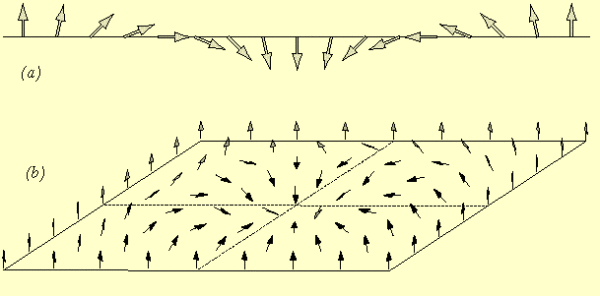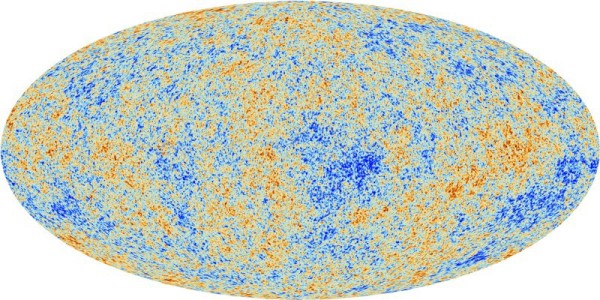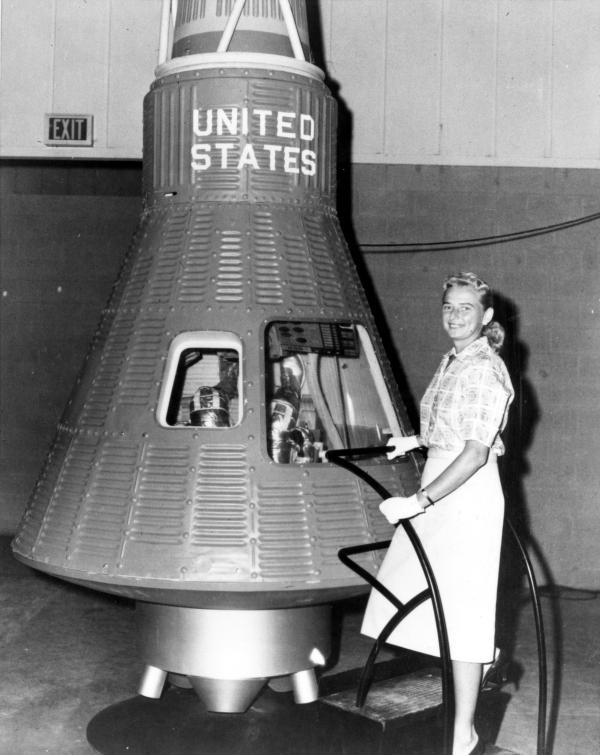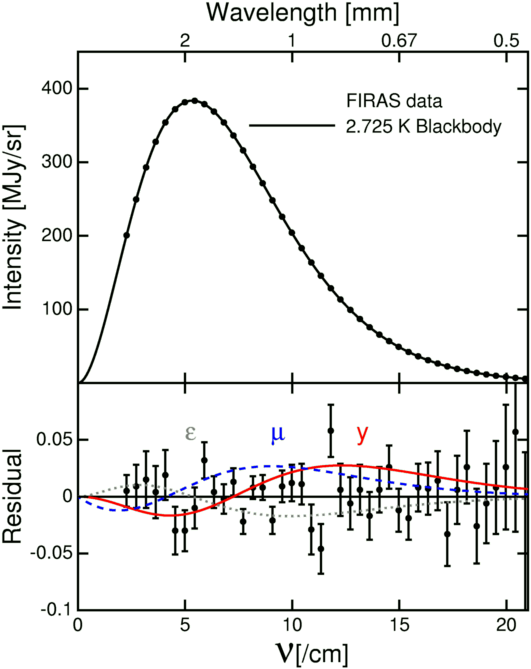"Sexism was the only thing that kept Jerrie Cobb out of space in 1960, and it cannot be allowed to stand in her way now." -Patricia Ireland
It isn't every week that you cover topics ranging from the birth of the Universe to the fundamental nature of space, and the go from sexism in NASA to the anthropic principle to... the math of reality television. But all that and more was on tap this past week at Starts With A Bang, with new articles on:
- What is dark energy? (for Ask Ethan),
- Had NASA believed in merit (for our Weekend Diversion),
- The Eagle Nebula, M16 (for Messier Monday),
- 10 things you didn't know about the anthropic principle (a great contribution from Sabine Hossenfelder),
- How the Big Bang's alternatives died, and
- The bad math of The Biggest Loser (for Throwback Thursday).
With around forty new comments to choose from on these articles alone, I'll never cover them all. But I will call out and give my responses to what I feel are both the best ones and the ones that offer the most opportunity for education -- right now -- on this, our latest edition of the Comments of the Week!
Image credit: the Cosmic Microwave Background of Penzias and Wilson, via http://astro.kizix.org/decouverte-du-17-mars-2014-sur-le-big-bang-decry….
From Sinisa Lazarek on dark energy and the CMB: "Here’s an idea or a question…. if Universe is isotropic, then all observers in it should measure CMB in the same way. No?"
When you look at the Cosmic Microwave Background, sure, you see a mostly uniform 2.725 K temperature, with tiny fluctuations on the scale of a hundred microKelvin and a dipole anisotropy that corresponds to our motion relative to the Hubble expansion of the Universe. If you figure out all the contents of the Universe -- normal matter, dark matter, dark energy, radiation, neutrinos, spatial curvature, etc. -- and you work out the math, you'll find that every unique temperature corresponds to a unique moment in time. Measuring the temperature right now of the CMB tells us how much time has passed since the Big Bang, and allows all observers in the Universe to synchronize their clocks with the event of the Big Bang.
But it isn't true all observers will measure the CMB in the same way. In fact, the CMB's fluctuations vary both in space and time!
These fluctuations that we observe now correspond to hot-and-cold spots that are only a few thousands-to-tens-of-thousands of light-years in size, at least at the time they are emitted. Someone observing the CMB just 100,000 years from now -- or someone observing them from any other galaxy in the Universe -- will see an entirely different "surface of last scattering" and an entirely different pattern of fluctuations. Statistically, it will be the same, and so assuming we stick around for hundreds of thousands of years, we can actually learn more about our Universe by watching how those CMB patterns change to very high precision over time. But when you look at the CMB fluctuations and think you're seeing the face of creation, keep in mind that it's only a snapshot of an ever-changing face, one that varies tremendously in both space and time!
Image credit: Quantum Stories, retrieved via http://cuentos-cuanticos.com/.
From Sili on dark energy: "Why do we have to interpret the cosmological constant as an energy inherent in space itself? Isn’t that putting it on the wrong side of Einstein’s equation? Couldn’t it just be a quirk of how space reacts to matter?"
Dark energy doesn't have to be a cosmological constant, or an energy inherent to space itself. Observationally, we are limited to the constraint that this appears to be a form of energy that has a uniform density throughout space and has an equation of state that gives it a pressure that's equal to the negative of its energy density (neglecting factors of things like c^2). Now, that could be an energy inherent to space itself; that's the easiest formulation. But if we wanted to move that to the "other" side of the Einstein equation -- meaning we make it a property of matter-and-energy, not of space-and-time -- we find that there is something that corresponds to.
 Image credit: Cambridge Cosmology, via http://www.damtp.cam.ac.uk/research/gr/public/cs_top.html.
Image credit: Cambridge Cosmology, via http://www.damtp.cam.ac.uk/research/gr/public/cs_top.html.
It's known as a cosmological texture, or a three dimensional topological defect. You could have a point (0-D) topological defect: that corresponds to a particle like a magnetic monopole, or possibly as simple as an electron. You could have a line (1-D) topological defect: that would be a cosmic string, a great linear discontinuity stretching across the Universe. You could have a domain wall (2-D) topological defect, a great wall separating one region of space from another. The strings and walls aren't observed, but the 3-D version of that would be a texture, which would be indistinguishable from a cosmological constant. But unless that texture doesn't cover the entire observable Universe, we'll never be able to tell it apart from a cosmological constant.
When I run into issues like this, though, I remember the difference between a physicist and a mathematician, and why I always say that I convince myself that something is true, rather than prove to myself that something is true. To quote Frank Wilczek, "In physics, your solution should convince a reasonable person. In math, you have to convince a person who's trying to make trouble. Ultimately, in physics, you're hoping to convince Nature. And I've found Nature to be pretty reasonable."
From Birger Johansson on the Jerrie Cobb story: "Actually, Edward Teller had no objections to women astronauts, but Lyndon Johnson and others did and a great opportunity was lost."
If only Edward Teller -- of atomic bomb fame -- had anything to do with the administration of NASA at the time. In truth, it would have been the NASA administrators who could have changed the policy, and the drafted letter referred to in the story would have wound up on the desk of James Webb, the former NASA administrator for whom the next generation space telescope is named.
But, since you brought it up, I believe that there was a pervasive mindset at the time that still exists today: the mindset of what I call compassionate sexism. It's the attitude that women shouldn't be allowed to do dangerous things because we don't want to see them get hurt. So no women in the military, because we're not okay with women getting shot and killed. No women working as loggers or on fishing boats or in the trades because those are professions were lethal accidents happen frequently. And no women strapping themselves to gigantic rockets filled with explosives, because it's too dangerous.
This form of sexism might not be as offensive as the kind that says "women aren't inherently as good as men," but it still has the same net effect: it denies women the opportunity to pursue the jobs, careers and opportunities that they would themselves choose in this life. It's sexism all the same, and while we can't do anything about the damage done in the past, we can all band together and agree it's high time that it end today.
 Image credit: Karen46 of http://www.freeimages.com/profile/karen46.
Image credit: Karen46 of http://www.freeimages.com/profile/karen46.
From Sean T on the topic of the Anthropic Principle: "At its best, it seems to me that the anthropic principle serves just as a sanity check on our understanding of physics. If we apply our current best knowledge of physics (or any other branch of science) and come to the conclusion that human life cannot exist because of some implication of our theories, then we know that we have to go back to the drawing board and look more closely at our theories. Of course, the anthropic principle is nothing special in that regard; ANY observational data serve the same purpose. Existence of human and other life is just one more observation with which our theories must be consistent."
I like this statement a lot, because it takes the "anthropos" out of the anthropic principle. The Universe didn't need us humans in it in order to exist. It existed just fine for billions of years before us and will continue to exist, most likely for much longer than that, long after we are gone. But we are here now, and as far as we know, each one of us is unique in all of space and time. That's something pretty special.
But we do take it for granted that the Universe that we live in had to be such that the processes that either are occurring now or that must have occurred in the past have to be admitted as a possibility. A Universe that held that the formation of stars were impossible, or that elements heavier than iron couldn't be created, or couldn't create bound atoms would have to be rejected. From one particular point of view, saying "the anthropic principle" is simply saying that the Universe must be allowed to exist in a way that's consistent with what's observed, and if your theoretical predictions don't admit for the possibility of the Universe turning out the way that it is, you'd better try again.
From Michael Kelsey on the certainty of the Big Bang: "I’ve got one question about the old COBE/FIRAS plots you show. They all label the Y-axis in units of [MJy/sr] (note the uppercase ‘M’). I read that as “megajanskys per steradian.” That can’t be right, can it?"
When you're measuring the energy coming from a large, diffuse source, you probably don't think of what units you'd use very often. Energy is typically measured in Joules, while the energy density is Joules-per-square-meter. When you're looking at light of a particular wavelength/frequency, it makes more sense to talk about power than energy, so a little more unit gymnastics will get you from Joules to Watts-per-frequency, and since 1 Watt is 1 Joule-per-second, and frequency is in units of inverse seconds, this works out. We measure flux density at a particular frequency in units of W / Hz · m^2.
In radio astronomy, though, you've got to remember you're looking at very long wavelengths, which corresponds to extremely tiny energies. You'll probably get tired of writing out all those minuscule numbers (even in scientific notation) after a while, so we use a different unit: the Jansky, which corresponds to 10^-26 W / Hz · m^2. A large, distant radio source might have a flux density here on Earth of 1 Jansky, or 1 Jy. So how is it, then, that the units we're measuring for the Cosmic Microwave Background (CMB), which is way more diffuse and way less energetic than a typical radio source, are being measured in units of MJy/sr?
 Image credit: the Cosmic Microwave Background of Penzias and Wilson, via http://astro.kizix.org/decouverte-du-17-mars-2014-sur-le-big-bang-decry….
Image credit: the Cosmic Microwave Background of Penzias and Wilson, via http://astro.kizix.org/decouverte-du-17-mars-2014-sur-le-big-bang-decry….
This means that the CMB, at each of these frequencies, has a flux density per unit area of hundreds of megaJanskys per steradian, where a steradian is a measure of solid angle. But it actually is right, and the reason is because a steradian is huge! There are 4π steradians (about 13 steradians) on the entire sky, which is a very small number. Consider that there are 41,253 square degrees on the sky, or that when the planet Mars is at its closest to Earth, it subtends a solid angle area of 11 nanosteradians. The CMB's flux density, instead of hundreds of MJy/sr, could also be given in single digits of Jy/Mars-at-its-closest, which is simply my way of saying that these units are, in fact, tiny.
Image credit: The Biggest Loser, Season 16, Episode 6, via http://www.hulu.com/watch/701390.
And finally, from Omega Centauri, summing up my post on the Bad Math of the Biggest Loser: "But then reality TV is just wrong in so many ways, arbitrariness is just one of its defects."
I suppose I don't mind arbitrary rules, myself, as long as those rules are consistently applied. I find it difficult, though, that if I'm in a show about weight loss where I weigh 300 pounds and one of my competitors weighs 290, I'll need to lose a full pound more than they will each and every week -- rather than an extra 3.4% of a pound -- if I want to finish with a better percentage on the scale.
My point is not that other things aren't terrible, but that the basic math fail is (apparently) where I draw the line!
Thanks for a great week of comments, and I'll see you back here soon for more wonders of the Universe!




"...while the energy density is Joules-per-square-meter"
?? Isn't
J=Nm = energy
energy density = J/m³ = N/m² = pressure
@SCHWAR_A #1; The context of the units discussion is observational astronomy. "Energy density" in this context is what we _observe_: energy reaching our detector (telescope, antenna, bolometer, whatever) from some _area_ of the sky (that giant crystalline sphere which surrounds the fixed, flat Earth :-). Hence, for observational astronomy, the units of energy density are joules per _square_ meter.
@Michael Kelsey #2: Thanks a lot, I was not aware of this special context...
( ...perhaps you also have an idea to this question? Thanks in advance...)